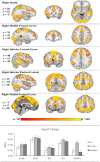An exploratory study of functional brain activation underlying response inhibition in major depressive disorder and borderline personality disorder
- PMID: 36608051
- PMCID: PMC9821521
- DOI: 10.1371/journal.pone.0280215
An exploratory study of functional brain activation underlying response inhibition in major depressive disorder and borderline personality disorder
Abstract
Cognitive control is associated with impulsive and harmful behaviours, such as substance abuse and suicidal behaviours, as well as major depressive disorder (MDD) and borderline personality disorder (BPD). The association between MDD and BPD is partially explained by shared pathological personality traits, which may be underpinned by aspects of cognitive control, such as response inhibition. The neural basis of response inhibition in MDD and BPD is not fully understood and could illuminate factors that differentiate between the disorders and that underlie individual differences in cross-cutting pathological traits. In this study, we sought to explore the neural correlates of response inhibition in MDD and BPD, as well as the pathological personality trait domains contained in the ICD-11 personality disorder model. We measured functional brain activity underlying response inhibition on a Go/No-Go task using functional magnetic resonance imaging in 55 female participants recruited into three groups: MDD without comorbid BPD (n = 16), MDD and comorbid BPD (n = 18), and controls with neither disorder (n = 21). Whereas response-inhibition-related activation was observed bilaterally in frontoparietal cognitive control regions across groups, there were no group differences in activation or significant associations between activation in regions-of-interest and pathological personality traits. The findings highlight potential shared neurobiological substrates across diagnoses and suggest that the associations between individual differences in neural activation and pathological personality traits may be small in magnitude. Sufficiently powered studies are needed to elucidate the associations between the functional neural correlates of response inhibition and pathological personality trait domains.
Copyright: © 2023 Cane et al. This is an open access article distributed under the terms of the Creative Commons Attribution License, which permits unrestricted use, distribution, and reproduction in any medium, provided the original author and source are credited.
Conflict of interest statement
The authors have declared that no competing interests exist.
Figures


Similar articles
-
Distinguishing bipolar II depression from major depressive disorder with comorbid borderline personality disorder: demographic, clinical, and family history differences.J Clin Psychiatry. 2013 Sep;74(9):880-6. doi: 10.4088/JCP.13m08428. J Clin Psychiatry. 2013. PMID: 24107761
-
Early life stress, resilience and emotional dysregulation in major depressive disorder with comorbid borderline personality disorder.J Affect Disord. 2018 Aug 15;236:113-119. doi: 10.1016/j.jad.2018.04.119. Epub 2018 Apr 27. J Affect Disord. 2018. PMID: 29730510
-
The effects of social exclusion on response inhibition in borderline personality disorder and major depression.Psychiatry Res. 2018 Apr;262:333-339. doi: 10.1016/j.psychres.2017.03.034. Epub 2017 Mar 28. Psychiatry Res. 2018. PMID: 28363497
-
The borderline diagnosis II: biology, genetics, and clinical course.Biol Psychiatry. 2002 Jun 15;51(12):951-63. doi: 10.1016/s0006-3223(02)01325-2. Biol Psychiatry. 2002. PMID: 12062878 Review.
-
Depression and borderline personality disorder.Med J Aust. 2013 Sep 16;199(6 Suppl):S24-7. doi: 10.5694/mja12.10474. Med J Aust. 2013. PMID: 25370280 Review.
Cited by
-
Biomarkers for Cognitive Control, Response Inhibition, Aggressivity, Impulsivity, and Violence.Adv Neurobiol. 2024;40:725-756. doi: 10.1007/978-3-031-69491-2_24. Adv Neurobiol. 2024. PMID: 39562462 Review.
-
The impact of childhood trauma on Adolescent Depressive Symptoms: the Chain Mediating role of borderline personality traits and self-control.BMC Psychiatry. 2024 May 21;24(1):377. doi: 10.1186/s12888-024-05829-6. BMC Psychiatry. 2024. PMID: 38773436 Free PMC article.
-
Application of Near-Infrared Spectroscopy in Early Detection of Antidepressant Treatment Efficacy in Major Depressive Disorder: A Longitudinal Study.Actas Esp Psiquiatr. 2025 Mar;53(2):275-283. doi: 10.62641/aep.v53i2.1708. Actas Esp Psiquiatr. 2025. PMID: 40071372 Free PMC article.
References
-
- Manasse SM, Forman EM, Ruocco AC, Butryn ML, Juarascio AS, Fitzpatrick KK. Do executive functioning deficits underpin binge eating disorder? A comparison of overweight women with and without binge eating pathology. International journal of eating disorders. 2015. Sep;48(6):677–83. doi: 10.1002/eat.22383 - DOI - PMC - PubMed
-
- Karlsgodt KH, Bato AA, Ikuta T, Peters BD, DeRosse P, Szeszko PR, et al.. Functional activation during a cognitive control task in healthy youth specific to externalizing or internalizing behaviors. Biological Psychiatry: Cognitive Neuroscience and Neuroimaging. 2018. Feb 1;3(2):133–40. doi: 10.1016/j.bpsc.2017.09.003 - DOI - PMC - PubMed
Publication types
MeSH terms
LinkOut - more resources
Full Text Sources

